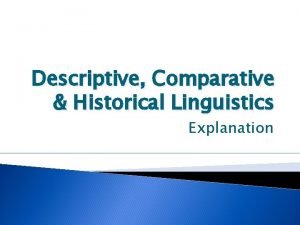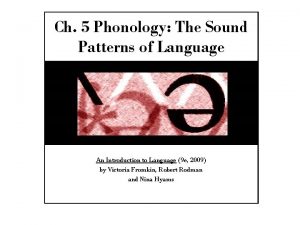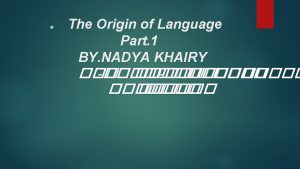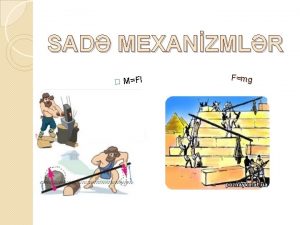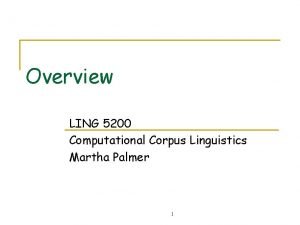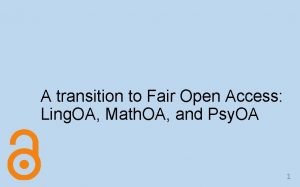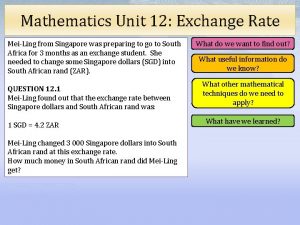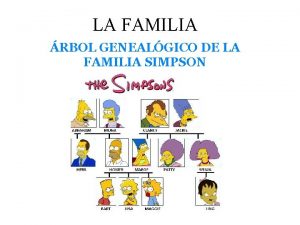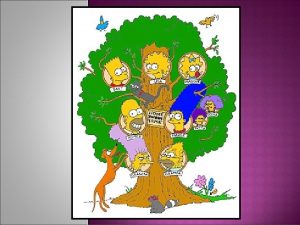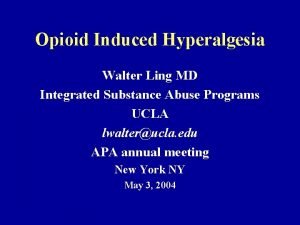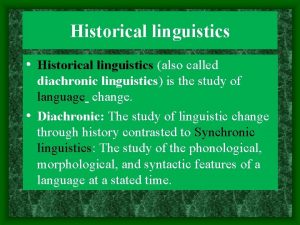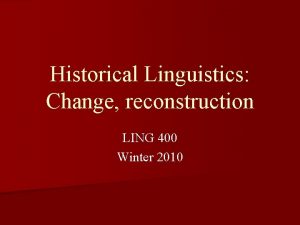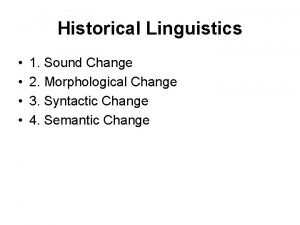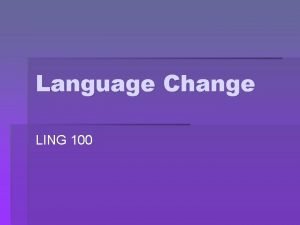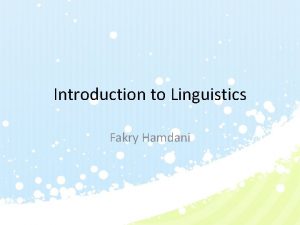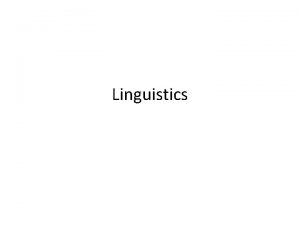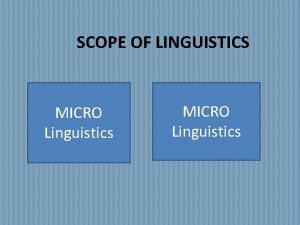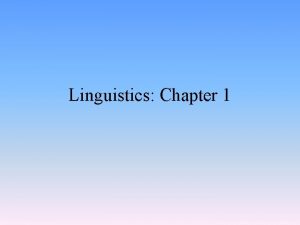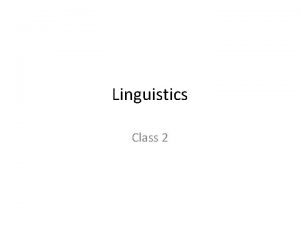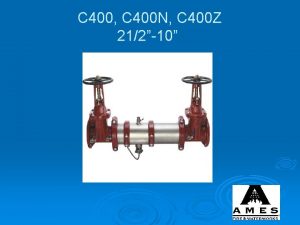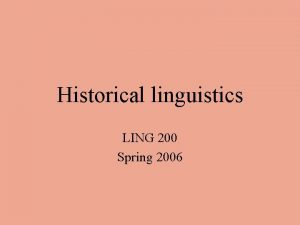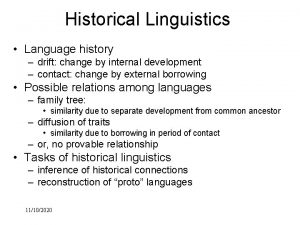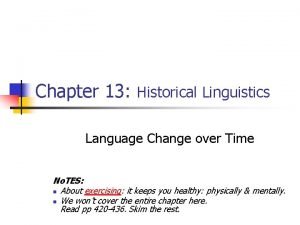Historical linguistics Language families sound change LING 400




![Question: which languages seem most similar? n n n n ‘water’: A- [the], B-[ʧi: Question: which languages seem most similar? n n n n ‘water’: A- [the], B-[ʧi:](https://slidetodoc.com/presentation_image/3e22682906734754fc97368690ce8c92/image-5.jpg)

















- Slides: 22

Historical linguistics: Language families, sound change LING 400 Winter 2010

Overview n n n Concepts, terms Language families and isolates Types, examples of historical change Please turn off your cell phone

Synchronic vs. diachronic linguistics n Synchronic linguistics n n How language works at one point in time Diachronic linguistics n n n A. k. a. historical linguistics How language changes over time Includes study of word histories (etymology) n n n diachronic: [f. Gr. διά “throughout, during” + χρόυ-ος “time” + -IC. ] synchronic: syn = [Latinized form of Gr. συν- (= σύν prep. with), “together, similarly, alike” …] Challenging

Similarities in form and meaning n May be due to n borrowing n n coincidence n n English beef < Old French boef Sahaptin [ʔɨ|ʃɨt] ‘worthless, useless’ inheritance from common ancestor
![Question which languages seem most similar n n n n water A the Bʧi Question: which languages seem most similar? n n n n ‘water’: A- [the], B-[ʧi:](https://slidetodoc.com/presentation_image/3e22682906734754fc97368690ce8c92/image-5.jpg)
Question: which languages seem most similar? n n n n ‘water’: A- [the], B-[ʧi: ʃ], C-[tho], D-[thu] ‘person’: A-[tə|nɑ], B-[ti: n], C-[tə|ni], D-[|təne] ‘sun’: A-[no|ʔoj], B-[ʔɑ: n], C-[sɑ C-[s ], D-[sɑ D-[s ] ‘I’: A-[se], B-[ʔink], C-[səj], D-[|sɪni] ‘scab’: A-[ɬet A-[ ], B-[|ʔɑwtɑʃ], C-[ɬot C-[ ], D-[ɬut D-[ ] ‘hand’: A-[lo A-[ ʔ], B-[ʔɨ|pɑp], C-[le C-[ ], D-[lɑ D-[ ʔ] ‘abdomen’: A-[v A-[ ət], B-[nɑ B-[ |wɑt], C-[pət], D-[pə t] A: Deg Xinag, B: Sahaptin, C: Witsuwit’en, D: Tsek’ene

Athabaskan family A. Deg Xinag D. Tsek’ene C. Witsuwit’en Sahaptian family Sahaptin Nez Perce

Language family Family Language Dialect … Language … Dialect… Idiolect … Idiolect …

Indo. European languages

Language families • Trees: show divergence over time Proto-Romance ( Latin) Spanish Portuguese Italian French Romanian. . . Spanish, Portuguese, Italian are daughters (descendants) of Proto-Romance

Ancestor languages Actually attested: Latin Hypothetical, reconstructed: Proto-Romance

Interpreting historical trees n n Order of nodes on same level doesn’t matter Equivalent trees

Proto-Anglo-Frisian Old English Old Frisian Middle English Modern Frisian https: //depts. washington. edu/llc/olr/linguistics/clips/#mother “Frisian” clip

‘Cognate’ and ‘reflex’ n n n Word descended from same source Proto-Indo-European *ped/pod ‘foot’ * = not attested Greek pod-, English foot are reflexes of *ped/pod ‘foot’ Greek pod-, English foot are cognates

Language isolate n No known related languages n n n Basque (France, Spain) Sumerian (extinct lg. of Iraq) Haida and Zuni (N. America)

Sound change n Phonetic change n n n Phonological change n n change in pronunciation of phonemes English rhotic: [r] > [ɹ] (most varieties of English) Change in phoneme inventory Regularity of sound change

Change in phoneme inventory n Proto-Indo-European > Old Irish n n *pətēr ‘father’ > athair [a|θarj] *nepot- ‘nephew’ > nie *tepent-s ‘warm’ > tëe PIE had /p/; Old Irish lacks /p/

Unconditioned sound change merger

Grimm’s Law

Conditioned sound change n Old English /ü/ > Modern English /ʌ/ / ___r. C n n n wyrst [würst] > worst wyrcan [würkan] > work gyrdel [gürdɛl] > girdle byrþen [bürθɛn] > burden Elsewhere, Old English /ü/ > Modern English /ɪ/ n n cynn [kün] > kin hyll [hül] > hill synn [sün] > sin pytt [püt] > pit

Modern English voiced fricatives n Old English /f θ s/ n n 700 A. D. addition of intervocalic voicing rule n n fiif ‘five’, wulf ‘wolf’, ofer ‘over’, weorþan, wearþ ‘to become’/’became’, þing ‘thing’, sendan ‘to send’, nosu ‘nose’, wesan/wæs ‘to be’/’was’ [over], [weorðan], [nozu]; [v ð z] in complementary distribution with [f θ s] Other changes to the language n n Borrowings from Kentish (dialect map next slide) Fricatives voiced fricatives word-initially in Kentish n n n væt ‘barrel’ replaced fæt vyxen ‘female fox’ replaced fyxen Shortening of intervocalic long voiceless fricatives: [ff] > [f], [θθ] > [θ], [ss] > [s] Middle English final [ə] loss: [bāðə] ‘bathe’ > [bāð] Now [f v] (etc. ) contrast in all environments; split

Major OE dialect areas West Saxon (most OE docs) Mercian > Modern English Kentish Northumbrian

Summary n Historical linguistics n n n language change over time is challenging Language families and isolates
 800+200+400
800+200+400 Big families vs small families
Big families vs small families Traditional linguistics and modern linguistics
Traditional linguistics and modern linguistics Difference between linguistics and applied linguistics
Difference between linguistics and applied linguistics Scope of historical linguistics
Scope of historical linguistics Historical linguistics
Historical linguistics The sound patterns of language
The sound patterns of language What is divine source in linguistics
What is divine source in linguistics Jin ling cigarettes
Jin ling cigarettes Tərpənən tərpənməz blok
Tərpənən tərpənməz blok Ling
Ling Erin ling
Erin ling Ling oa
Ling oa Mei-ling from singapore was preparing
Mei-ling from singapore was preparing Ling es la hija de selma
Ling es la hija de selma Dr ng li ling
Dr ng li ling Nien-ling wacker
Nien-ling wacker 施玲玲
施玲玲 Ling simpson
Ling simpson Ling adder
Ling adder Johann bernhard basedow contribution in physical education
Johann bernhard basedow contribution in physical education Walter ling
Walter ling Ling
Ling




